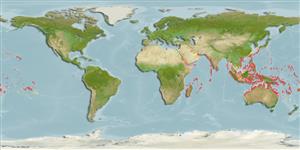>
Eupercaria/misc (Various families in series Eupercaria) >
Labridae (Wrasses) > Corinae
Etymology: Hemigymnus: Greek, hemi = half + Greek, gymnos = naked (Ref. 45335).
More on author: Bloch.
Environment: milieu / climate zone / depth range / distribution range
Ecologia
marino associati a barriera corallina; distribuzione batimetrica 0 - 25 m (Ref. 90102). Tropical; 30°N - 30°S, 33°E - 122°W
Indo-Pacific except the Red Sea.
Size / Peso / Age
Maturity: Lm ? range ? - ? cm
Max length : 30.0 cm TL maschio/sesso non determinato; (Ref. 93095)
Short description
Chiavi di identificazione | Morfologia | Morfometria
Spine dorsali (totale) : 9; Raggi dorsali molli (totale) : 10 - 11; Spine anali: 3; Raggi anali molli: 11. Lips thick with age (Ref. 1623). Several color phases with age and sex (Ref. 48636). Basic color pattern changes little with growth although the posteriormost white bands disappear on large individuals (Ref. 1602).
Found mostly on coral reefs and reef flats to at least 20 m depth. Juveniles secretive on inshore reefs. Large adults swim openly on reefs, singly or in small loose aggregations (Ref. 48636). Adults feed mainly by taking mouthfuls of sand and gravel, releasing sand from the gill opening after sorting the small animal prey and ejecting the inorganic fragments from the mouth. Gut contents may contain shrimps and 25% the crushed remains of the echinoids Echinometra and Diadema, these were large prey; remaining food material consisted of very small gastopods, bivalves, crabs, ophiuroids, foraminiferans, and unidentified eggs (Ref. 93095). Feed mainly on small crustaceans, mollusks and echinoderms (Ref. 9823). Minimum depth reported taken from Ref. 128797.
Life cycle and mating behavior
Maturities | Riproduzione | Spawnings | Egg(s) | Fecundities | Larve
Oviparous, with distinct pairing during breeding (Ref. 205).
Randall, J.E., 2013. Review of the Indo-Pacific labrid fish genus Hemigymnus. J. Ocean Sci. Found. 6:2-18. (Ref. 93095)
IUCN Red List Status (Ref. 130435)
Threat to humans
Harmless
Human uses
Pesca: scarso interesse commerciale; Acquario: Commerciale
Strumenti
Special reports
Download XML
Fonti Internet
Estimates based on models
Preferred temperature (Ref.
123201): 24.9 - 29.3, mean 28.3 °C (based on 3355 cells).
Phylogenetic diversity index (Ref.
82804): PD
50 = 0.6250 [Uniqueness, from 0.5 = low to 2.0 = high].
Bayesian length-weight: a=0.00977 (0.00470 - 0.02030), b=3.07 (2.89 - 3.25), in cm total length, based on LWR estimates for this (Sub)family-body shape (Ref.
93245).
Trophic level (Ref.
69278): 3.5 ±0.37 se; based on food items.
Resilienza (Ref.
120179): Medio, tempo minimo di raddoppiamento della popolazione 1.4 - 4.4 anni (Preliminary K or Fecundity.).
Fishing Vulnerability (Ref.
59153): Low vulnerability (20 of 100).
Nutrients (Ref.
124155): Calcium = 35.1 [18.8, 107.6] mg/100g; Iron = 0.593 [0.350, 1.070] mg/100g; Protein = 18.6 [15.7, 20.8] %; Omega3 = 0.157 [0.081, 0.315] g/100g; Selenium = 29.4 [10.5, 74.1] μg/100g; VitaminA = 115 [36, 404] μg/100g; Zinc = 2.88 [0.91, 4.94] mg/100g (wet weight); based on
nutrient studies.
